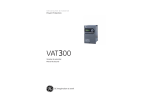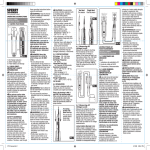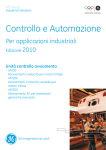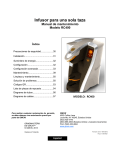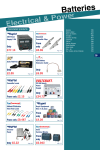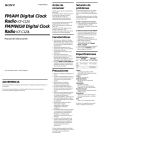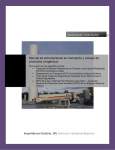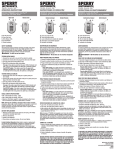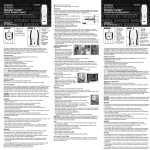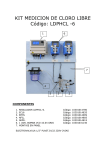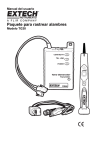Download Volt Doctor™ - Sperry Instrument
Transcript
VC6300 Volt Doctor 7/24/06 10:33 AM Page 1 is reserved for conditions and actions that can cause injury or instrument damage. VC6300 SPERRY ! DANGER INSTRUMENTS Volt Doctor Never make measurement on a circuit in which voltage over AC 600 V exists. • Do not attempt to take measurements in the presence of flammable gasses. Otherwise, the use of the instrument may cause sparking, which can lead to an explosion. ™ Beeper / Light For testing probes slide down from top No Reaction • This tester is designed for intermittent duty only (On 15 seconds, Off 240 seconds). It should only take several seconds to note a voltage indication. If the reading is maintained longer than 15 seconds, damage to the unit may occur. Voltage and Continuity Tester ! WARNING Never attempt to use the instrument if its surface or your hand is wet. • Read this owners manual thoroughly before use and save. • Do not exceed the maximum allowable input of any measuring range. • Never open the battery cover during a measurement. 2150 Joshua’s Path, Suite 302, Hauppauge, NY 11788 1-800-645-5398 • www.sperryinstruments.com • The instrument is to be used only in its intended applications or conditions. Otherwise, safety functions equipped with the instrument don’t work, and instrument damage or serious personal injury may be caused. Never attempt to make measurements if any abnormal conditions, such as ! WARNING broken case or exposed metal parts are found on the instrument. 1.0 METER FUNCTIONS 1. DC Polarity Indicators 2. AC/DC Voltage Scale 3. Probe Holders and Storage 4. Continuity Indicator 5. Battery Compartment 1 4 2 • Do not install substitute parts or make any modification to the instrument. For repair or re-calibration, return the instrument to your local distributor from where it was purchased. • Disconnect all the cords and cables from the object under test before opening the battery cover for battery replacement. • Verify proper operation on a known source before use or taking action as a result of the indication of the instrument. Use appropriate personal protective equipment such as insulating gloves, insulating boots, and safety glasses. • Do not expose the instrument to the direct sun, high temperature and humidity or dewfall. • Using the meter in areas with high magnetic fields can result in inaccurate readings. • Altitude 2000m or less. Appropriate operating temperature is within 32 °F – 104 °F (0 °C – 40 °C). 3 • This instrument isn’t dust and water proofed. Keep away from dust and water. • When the instrument will not be in use for a long period, place it in storage after removing the batteries. 5 • Cleaning: Use a cloth dipped in water or neutral detergent for cleaning the instrument. Do not use abrasives or solvents otherwise instrument may get damaged, deformed or discolored. 3.0 SPECIFICATIONS 2.0 READ FIRST: IMPORTANT SAFETY INFORMATION Read this operators manual thoroughly before using this meter. This manual is intended to provide basic information regarding this meter and to describe common test procedures which can be made with this unit. Many types of appliance, machinery and other electrical circuit measurements are not addressed in this manual and should be handled by experienced service technicians. Use extreme caution when using this meter. Improper use of this ! WARNING meter can result in severe damage to property, severe personal injury or death. Follow all instructions and suggestions in this operators manual as well as observing normal electrical safety precautions. Do not use this meter if you are unfamiliar with electrical circuits and proper test procedures. SAFETY WARNINGS This instrument has been designed, manufactured and tested according to IEC61010: Safety requirements for Electronic Measuring apparatus, and delivered in the best condition after passing inspection. This instruction manual contains warnings and safety rules which must be observed by the user to ensure safe operation of the instrument and retain it in safe condition. Therefore, read through these operating instructions before using the instrument. DC Voltage: 120 - 600 Volts AC Voltage: 120 - 600 Volts AC Voltage Frequency: 50 - 60 Hz Intermittent Duty Only! On 15 seconds, Off 240 seconds Operation Environment: 32 °F – 104 °F (0 °C – 40 °C), 80% RH Max. 50% RH above 31 °C 4.0 OPERATION This meter is designed with probe holders to allow for maximum versatility and single hand testing. Refer to the drawings in Fig. 1 for common setups. Automatic Operation • The instrument is to be used only in its intended applications. When using the test leads, the tester will automatically activate when connected to AC or DC voltage. The tester will automatically select the proper function. • Understand and follow all the safety instructions contained in the manual. 4.1 Testing Continuity • It is essential that the above instructions are adhered to. Touch the tip of the test leads to the points where tests need to be made. If the resistance is below 50 ohms, the continuity light at the top will illuminate. Fig. 2 ! WARNING Keep the manual at hand to enable quick reference whenever necessary. • Failure to follow the above instructions may cause injury, instrument damage and/or damage to equipment under test. ! DANGER is reserved for conditions and actions that can cause serious or fatal injury. Fig. 1 Two Hand Fig. 2 4.2 Measuring DC Voltage Levels Measure the voltage by touching the test lead tips to the circuit where the value of voltage is needed. If the yellow test lead is on the positive contact the +VDC light will illuminate. If the yellow test lead is on the negative contact the -VDC light will illuminate. Fig. 3 Read the voltage level from the DC voltage scale. 4.3 Measuring AC Voltage Levels Measure the voltage by touching the test lead tips to the circuit where the value of voltage is needed. Both polarity indicators will illuminate to indicate AC Voltage. Fig. 4 Read the level from the AC voltage scale. The polarity of the leads does not matter for AC voltage measurements. Yellow Black Fig. 3 5.0 CHANGING THE BATTERIES Altitude up to 2000 meters. Indoor use. Storage Temperature: 14 °F – 140 °F (-10 °C – 60 °C) Batteries: (2) 1.5 V button cells CAT III 600V Fig. 1 Single Hand Do not open tester case while using the tester. 1) When the battery voltage drops below proper operating range, the tester will no longer function. 2) Slide rubber boot at the bottom of the tester out of the way and remove the screw to access the battery compartment. 3) Slide the bottom out and replace with (2) 1.5 Volt button cell batteries (LR44, SR44, A76, G13, AG13, GP76A, 257, D357, V13GA. 4) Replace battery door, screw and rubber boot to original positions. 5) Test on known live circuit to verify proper operation. Also test continuity function by touching the two leads together. (Refer to 1.0, Meter Functions) Fig. 4 VC6300 Volt Doctor 7/24/06 10:33 AM Page 2 VC6300 SPERRY INSTRUMENTS ¡PELIGRO! se reserva para condiciones y acciones que pueden causar lesiones serias o fatales. ! PRECAUCION! se reserva para condiciones y acciones que pueden causar lesiones o daño al instrumento. ! ! Voltage Doctor ™ ! ¡PELIGRO! Nunca tome medidas en un circuito donde exista voltaje sobre 600V de CA. Probador de voltaje y continuidad • No intente tomar medidas en la presencia de gases inflamables. De lo contrario, el uso del instrumento puede causar chispas, lo cual puede ocasionar una explosión. • Lea este manual del propietario totalmente antes del uso y ahorre. • Este probador está diseñado sólo para servicio intermitente (encendido 15 segundos, apagado 240 segundos). Debe tardar sólo unos segundos anotar una indicación de voltaje. Si se mantiene la lectura más de 15 segundos, puede dañarse la unidad. ! \2150 Joshua's Path, Suite 302, Hauppauge, NY 11788 1-800-645-5398 • www.sperryinstruments.com ¡ADVERTENCIA! Señal sonora/Luz Para probar las sondas deslice hacia abajo desde arriba No hay reacción Nunca intente usar el instrumento si está mojada la superficie o la mano. • No supere la entrada máxima permisible de cualquier rango de medición. • El instrumento debe usarse solamente en las aplicaciones o condiciones contempladas. De lo contrario, las funciones de seguridad con las cuales se ha equipado el instrumento quedan inoperantes, y puede causarse daño al instrumento o lesiones físicas serias. 1.0 FUNCIONES DEL MEDIDOR 2 ¡ADVERTENCIA! Nunca intente tomar medidas si se encuentra alguna condición anormal, tal como la caja rota o piezas metálicas expuestas en el instrumento. • No sustituya piezas ni haga modificaciones al instrumento. Para reparar o recalibrar el instrumento, devuélvalo a su distribuidor local donde lo compró. • Desconecte todos los cordones y cables del objeto a prueba antes de abrir la tapa de la batería para cambiar la batería. • Verifique el funcionamiento correcto en una fuente conocida antes de usar o de actuar basándose en lo que indicó el instrumento. ! 1. Indicadores de polaridad de CC 2. Escala de voltaje de CA/CC 3. Portasondas y almacenamiento 4. Indicador de continuidad 5. Compartimiento de batería 1 4 ! ! PRECAUCION! Use el equipo protector personal adecuado como guantes aisladores, botas aisladoras y anteojos de seguridad. • No exponga el instrumento al sol directo, a alta temperatura ni humedad o caída de rocío. • Si se usa el medidor en áreas con campos magnéticos altos puede ocasionar lecturas imprecisas. 3 • Altitud de 2000 m o menor. La temperatura operativa adecuada está entre 32 °F – 104 °F (0 °C – 40 °C). • Este instrumento no es a prueba de polvo ni agua. Manténgalo alejado del polvo y del agua. 5 • Cuando el instrumento no vaya a estar en uso por un tiempo largo, póngalo en almacenamiento después de extraerle las baterías. • Limpieza: Use un paño sumergido en agua o detergente neutro para limpiar el instrumento. No use abrasivos ni solventes, de lo contrario el instrumento puede dañarse, deformarse o decolorarse. 2.0 LEER PRIMERO: INFORMACIÓN IMPORTANTE DE SEGURIDAD 3.0 ESPECIFICACIONES Lea este manual del operador totalmente antes de usar este medidor. Este manual está destinado a brindar información básica referente a este medidor y a describir procedimientos comunes de prueba que pueden realizarse con esta unidad. Muchos tipos de mediciones de circuitos eléctricos, artefactos y maquinarias no se describen en este manual y deben realizarlas los técnicos de servicio experimentados. ¡ADVERTENCIA! Tenga sumo cuidado al utilizar este medidor. El uso indebido de este ! medidor puede producir graves daños materiales, además de lesiones físicas serias o fatales. Siga todas las instrucciones y sugerencias en este manual del operador y observe también las precauciones de seguridad normales con la electricidad. No use este medidor si no está familiarizado con los circuitos eléctricos y los procedimientos correctos de prueba. Voltaje de CC: 120 - 600 Voltios Voltaje de CA: 120 - 600 Voltios Frecuencia de voltaje de CA: 50 - 60 Hz ¡Sólo servicio intermitente! Encendido 15 segundos, apagado 240 segundos Ambiente operativo: 32 °F – 104 °F (0 °C – 40 °C), 80% de humedad relativa máx. 50% de humedad relativa sobre 31 °C ADVERTENCIAS DE SEGURIDAD Este instrumento ha sido diseñado, fabricado y probado conforme a IEC61010: Requisitos de seguridad para aparatos electrónicos de medición, y se entrega en el mejor estado después de pasar la inspección. Este manual de instrucciones contiene advertencias y reglas de seguridad que el usuario debe observar para garantizar el funcionamiento seguro del instrumento y mantener su estado sin presentar peligro. Por lo tanto, lea estas instrucciones operativas antes de usar el instrumento. ! ¡ADVERTENCIA! Conserve a mano el manual para poder usarlo a modo de referencia rápida siempre que sea necesario. • El instrumento debe usarse solamente en las aplicaciones contempladas. • Entienda y siga todas las instrucciones de seguridad contenidas en el manual. • Es esencial que se respeten las instrucciones anteriores. • Si no se siguen las instrucciones anteriores puede causar lesiones, daño al instrumento y/o daño al equipo a prueba. Altitud de hasta 2000 metros. Uso en interiores. Dos manos Temperatura de almacenamiento: 14 °F – 140 °F (-10 °C – 60 °C) Baterías: (2) pilas de botón de 1.5 Voltios CAT III 600V 4.0 OPERACIÓN Este medidor se ha diseñado con portasondas para permitir máxima versatilidad y realizar pruebas usando una sola mano. Consulte los esquemas de la Fig. 1 para ver las configuraciones comunes. Funcionamiento automático Al usar los electrodos de prueba, el probador se activará automáticamente al conectarse al voltaje de CA o CC. El probador seleccionará automáticamente la función correcta. Fig. 1 Una sola mano Fig. 1 Fig. 2 4.1. Prueba de la continuidad Toque con las puntas de los electrodos de prueba los puntos donde se necesita realizar las pruebas. Si la resistencia es inferior a 50 ohmios, se iluminará la luz de continuidad arriba. Fig. 2 4.2 2 Medición de los niveles de voltaje de CC Mida el voltaje tocando el circuito con las puntas de los electrodos donde se necesite el valor del voltaje. Si el electrodo de prueba amarillo está en el contacto positivo se iluminará la luz +VCC. Si el electrodo de prueba amarillo está en el contacto negativo se iluminará la luz -VCC. Fig. 3 Lea el nivel de voltaje desde la escala de voltaje de CC. 4.3 Medición de los niveles de voltaje de CA Amarillo Negro Fig. 3 Mida el voltaje tocando el circuito con las puntas de los electrodos donde se necesite el valor del voltaje. Se iluminarán ambos indicadores de polaridad para indicar el voltaje de CA. Fig. 4 Lea el nivel desde la escala de voltaje de CA. No importa la polaridad de los electrodos para las mediciones de voltaje de CA. 5.0 CAMBIO DE LAS BATERÍAS No abra la caja del probador mientras lo use. 1) Cuando el voltaje de la batería baje del rango operativo adecuado, ya no funcionará el probador. 2) Deslice el manguito de caucho en la parte inferior del probador para que no estorbe y quite el tornillo para acceder al compartimiento de la batería. 3) Deslice la parte inferior hacia afuera y Fig. 4 cambie por (2) baterías de botón de 1.5 Voltios (LR44, SR44, A76, G13, AG13, GP76A, 257, D357, V13GA). 4) Vuelva a colocar la puerta de las baterías y el manguito de caucho en sus posiciones originales. 5) Pruebe con un circuito energizado conocido para verificar que funcione bien. Pruebe también la función de continuidad tocando juntos los dos electrodos. (Consulte 1.0, Funciones del medidor)




